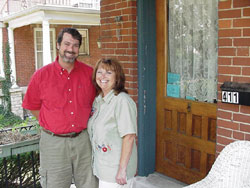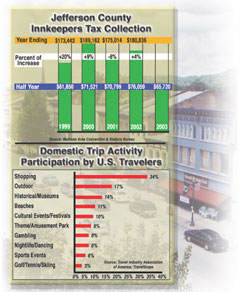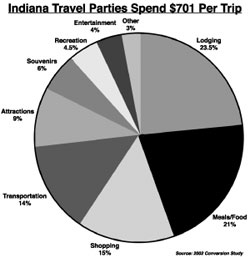



Tourism Trends
Local,
state tourism sites riding out
rough economic times
Lanier
Mansion, HMI among victims;
state seeks ways to boost tourism spending
(See
Kentucky Tourism Trends)
By
Don Ward
Editor
MADISON, Ind. (Sept. 2003) – Mike and Bobette Fessler
moved to Madison, Ind., from Indianapolis in 1997 to open Vintage Views
Bed & Breakfast across the street from the town’s busiest tourism
attraction, the Lanier Mansion Historic Site. For two years, business
was booming. Then came the 9/11 terrorist strikes, and like most hospitality
establishments in the area, their business has never been the same.
 |
|
Photo by Don Ward Mike
and Bobette Fessler |
The Fesslers are not alone among their tourism industry peers in their struggle to deal with the nation’s economic downturn, gasoline prices approaching $2 per gallon, war abroad and Americans’ continued fears of possibly more terrorism on our shores.
In the aftermath of 9/11, state and local tourism offices in Indiana and across the country are having to ride out these lean economic times by cutting back and getting more out of fewer resources.
In Madison, Ind., a historic town of 13,000 that relies heavily on the seasonal tourism trade, tourism was off 50 percent by some estimates in the months following the attack. Hotels and state parks have seen their numbers decline, while visitors to the Madison Area Convention and Visitors Bureau fell significantly before showing signs of a slow recovery late this summer.
What is more, mounting bills have stretched operating and cut into marketing budgets like never before. The state-owned and operated Lanier Mansion State Historic Site has experienced a cut in its operating budget. Officials there have their hopes riding on an effort to pass legislation mandating admission fees for the first time at all 14 state-owned historic sites. Visitation has also fallen dramatically at Historic Madison Inc.’s sites. The non-profit preservation group depends heavily on its membership and tourism for its livelihood.
 |
|
Tourism
Grid on Jefferson County
Innkeepers Tax Collection |
To cope, the Fesslers are trying to establish an in-house catering business and plan to mount their own publicity mail campaign to generate traffic. “The biggest comment we get from our guests is why haven’t they heard of Madison before now? They have all heard of Brown County, but Madison is much easier to get to; that’s why we chose to open our business here,” Fessler said.
Madison hoteliers say people are waiting longer to book lodging or plan trips, with many calling at the last minute. “We would normally be full by now (late August) for Chautauqua, but we’ve still got 20 rooms available,” said Renie Stephens, general manager of the Holiday Inn Express who is in her third year on the CVB board. “This is very unusual for us.”
 |
|
Linda Lytle |
Meanwhile, Holiday Inn Express has filled 40 percent of its rooms with temporary construction workers from the new Lowe’s Home Improvement center and an overhaul project taking place at Indiana-Kentucky Electric Corp.’s power plant. Stephens also has played a central role in organizing a lodging group in Madison that meets monthly with the CVB’s Lytle to express their needs and ideas. “It has given us a voice in what is going on and to see where the marketing money is going,” Stephens said.
She said the communication has resulted in more newspaper and magazine ads placed by the CVB with regard to lodging packages, and the ads have produced results. “I think it’s good that the CVB allows the lodging people to give their input,” Stephens said. “That’s the way it should be.”
Her optimism for full recovery, however, is tempered with reality. “I don’t see it coming back the way it was.”
Visitation in a slump
Another indicator of visitation might be the automatic door counts at the Lanier-Madison Visitors Center. While not perfect, since it counts staff and other non-visitors entering the building, the counts have declined every month except June this year, compared to last year. No counts are available for March and April when the staff was in the process of moving from Main Street to its new location at 601 W. First St.
Since moving into the new Visitors Center, Lytle said her staff has been trying to use the side doors to avoid impacting the true visitation numbers, however, she admits that many local people doing business at the center still use the front door. Over the past four years, the counts show a steady increase in traffic to the center, with the exception of 2000.
The CVB staff also tries to keep monthly records of visitors signing the guest register, website hits and toll free calls to the center, but those numbers are also inconsistent and in some cases incomplete for 2003 because of the move or the methods in which the counts are tallied.
Meanwhile, the CVB board in September must approve a $264,000 operating budget for 2004 that is several thousand dollars short of its mark, and she doesn’t yet know from where the money will come. The proposed budget projects innkeepers tax at the same level as the previous year, with little increase in income from other sources. The projected expenses, however, have risen significantly, in part because of the cost of a mandatory two-year state audit, which is being estimated as high as $10,000.
Tax records from 2002 show that the not-for-profit board has nearly $125,000 in cash and savings, but most of that is in the Madison Chautauqua Festival of Art bank account. That money is kept separate from the operating budget, Lytle said. The 32-year-old Chautauqua is by far the CVB’s most profitable event of the year, but records show it takes nearly $80,000 to stage. Lytle said dipping into the Chautauqua account to cover operating expenses in a lean year is “not an option because we have always let them function separately from us.” The coordinator’s $23,000 annual salary, however, is paid out of the operating budget.
Lanier Mansion attendance declines
Across the hall at the Lanier Mansion office, curator Link Ludington is fighting a similar problem. Visitation has dropped every year since 1997, with the last two being significant. The 2002 attendance of 15,342 is down by half of what it was in 1997, although the counting system changed in 2000 to include only those who actually tour the site and not those who visit the site during events such as Lanier Days or Chautauqua. Still, when using comparative numbers, last year’s mark is significantly below the 19,868 who toured the mansion in 2001, and even less than the 21,609 who visited in 2000.
 |
|
Link
Ludington
|
The state-ordered cuts amounted to $123,000 of thisyears $2.4 million operating budget for the sites. An appropriation of $911,000 passed in 2001, however, was released in July to pay for capital improvements. Lanier Mansion stands to receive $6,000 to repair the roof of the cupola, which has a water leak, according to Laura Minzes, deputy director of the state’s historic sites.
“We lost a full-time position here in Indianapolis, we’ve cut equipment and services purchases, and we haven’t bought anything substantial since 1998,” Minzes said.
Lanier’s ongoing project to reconstruct a former carriage house on the property and the cost to move into the new offices at the Lanier-Madison Visitors Center have been paid for by grants and private money from the Lanier Mansion Foundation.
A bill now being crafted in committee for the second consecutive year that would establish admission fees at each of Indiana’s state historic sites would replace the current donation system in place and generate a projected $300,000 a year after deducting the cost of collecting the fees. Donations at Lanier Mansion reaped only $25,078 in 2002, or $1.60 per visitor. Across all state historic sites, donations totaled $220,000, or about 62 cents per visitor.
 |
|
John
Staicer
|
Under the admission fee system, only 60 percent of the money would be controlled by the administration at each site, Ludington said. The other 40 percent would go to a central fund at the state level to better promote all the sites.
While the money would certainly help, Ludington said that state officials project as much as a 10 percent drop in attendance because some people would be unwilling to pay to tour the sites. “We don’t expect a huge windfall, but it’s difficult to predict what would happen until it’s implemented,” he said. With increased funding via admission fees, state officials “will be looking at how additional publicity might impact visitation,” he said.
Historic Madison Inc. numbers down
From April 2000 to July 2003, Historic Madison Inc. has seen a steady decline in attendance dipping as much as 32 percent at the three historic sites where public tours are offered, according to executive director John Staicer. That is despite a 12 percent increase in attendance this year.
Staicer said the increase could be attributed to the resumption of visits in Madison by the Delta Queen Steamboat Co. The company’s paddlewheelers made nine of its scheduled 16 stops this year between March and July. There were no stops last year after the company went bankrupt and was later sold to a new owner.
“The riverboat groups are an important audience for us, and I think it’s great that the Delta Queen Steamboat Company has its boats stop in Madison,” Staicer said.
Bus tours are also important, but Staicer said HMI had seen fewer bus tours stopping at its sites this year than in past years. “I haven’t even seen many buses in town this summer, which is a concern. That’s a captive audience that we like – usually senior citizens and people who have an interest in historic preservation.”
HMI offers tours from April through October at the Jeremiah Sullivan House, the Francis Costigan House and Dr. Hutchings Office and Hospital, all located in Madison’s downtown historic district. The attendance figures do not include visitation at the Schroeder Saddletree Factory and Museum, which just opened to tours last year.
Staicer said he considers a concern any cuts to the CVB marketing budget “because HMI, like everyone else in town, relies heavily on the CVB for marketing and visitation.” He added that there have been no travel writers in town this year as in recent years. “We find that word-of-mouth and stories in travel publications work well in promoting our sites.”
Staicer cited the tourism office’s struggle to get its new visitors center open after having its move-in date delayed several times as a possible factor in booking bus tours and promoting local attractions to visitors. “We’re hoping that once the new visitors center is open and becomes more well known to tourists and more fully operational that it will help us,” he said.
Lytle’s office is still working out the details with Lanier officials over internal signage and exhibits, which were supposed to have been ready by June and in plenty of time before Chautauqua. The gift shop is open and tourism literature is available, but the promotional displays and exhibits are not ready.
State and national trends.
 |
|
Tourism
Pie Chart showing Travel Parties'
percent in spending for Indiana |
Statewide and nationwide, the tourism picture is the same. Recent
events and a weakened economy since 9/11 have changed the tourism
landscape for everyone who depends on the travel and hospitality industry.
The stock market correction has left people with less disposable income
to spend on travel and leisure. The airline industry has been crippled
by air travel anxiety, and corporate travel budgets have been dramatically
altered. Fewer travelers spent less and took shorter trips in 2002.
All of this, according to the 2003 annual report by the Indiana Tourism
Council, a 33-member group chaired by Lt. Gov. Joe Kernan that advises
the Indiana Department of Commerce’s Office of Tourism Development.
Madison’s Lytle sits on the council, along with other statewide
tourism representatives.
“Indiana is at a critical point in determining the state’s
travel and tourism landscape over the next decade,” said the
report. “Industry leaders in 2002 recognized the need for different
marketing strategies, different alliances and different means of sustaining
the state’s tourism industry.”
Last year, 58 million visitors spent $6.7 billion in Indiana. Despite
that, the state continues to struggle with a competitive disadvantage
compared to its Midwest neighbors, the report said.
Indiana tourism ranks 42nd nationally in tourism funding. By contrast,
Illinois ranks second, Kentucky 29th and Ohio 33rd. The national average
is about $15 million.
Last year, a coalition of Indiana tourism industry officials backed
an effort to establish legislation that would have increased the state’s
spending on tourism marketing and development over a 10-year period.
Senate Bill 499, which died in committee, would have dedicated additional
money to tourism based on increases in tax revenue generated from
tourism-related businesses. The program was based on one that proved
successful in Missouri.
John Livengood, CEO of the Restaurant and Hospitality Association
of Indiana, was a major proponent of the bill and says the effort
may be revived in the state’s next budget cycle in 2005. For
now, the Promote Indiana Coalition is focusing its efforts on the
Department of Commerce’s study to restructure the Indiana Tourism
Division.
Livengood, who recently testified before the committee, said, “The
committee is looking at several options: Should it be a standalone
agency, part of the Department of Commerce, or become a new Department
of Tourism and Community Development?” The study committee convenes
again in October at a retreat in New Harmony, Ind.
The association, meanwhile, fighting to repeal recent legislation
that imposed a tax on complementary rooms at Indiana’s hotels
and casinos. “We see this as a punitive tax that basically tells
people, ‘Don’t come to Indiana because we don’t want
your business.’ “ Livengood said.
Despite differing views on how to do it, Indiana’s tourism industry
generally agrees that something must be done soon to pull tourism
funding within range of regional tourism offices’ budgets. “Considering
what other states spend in our region, we need to be up to about $12
million to be competitive,” Livengood said, “ and right
now we’re about one-third of that.”